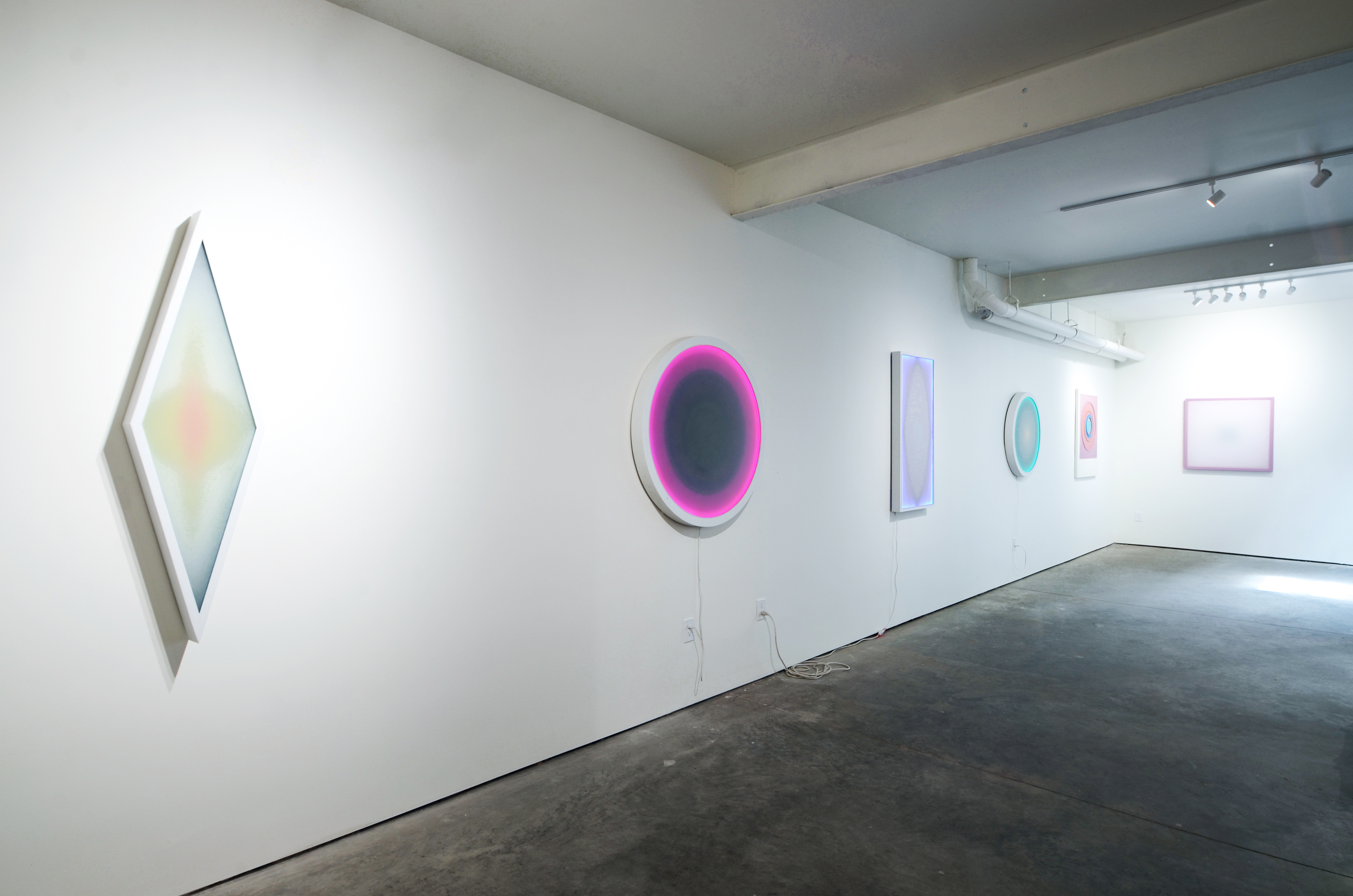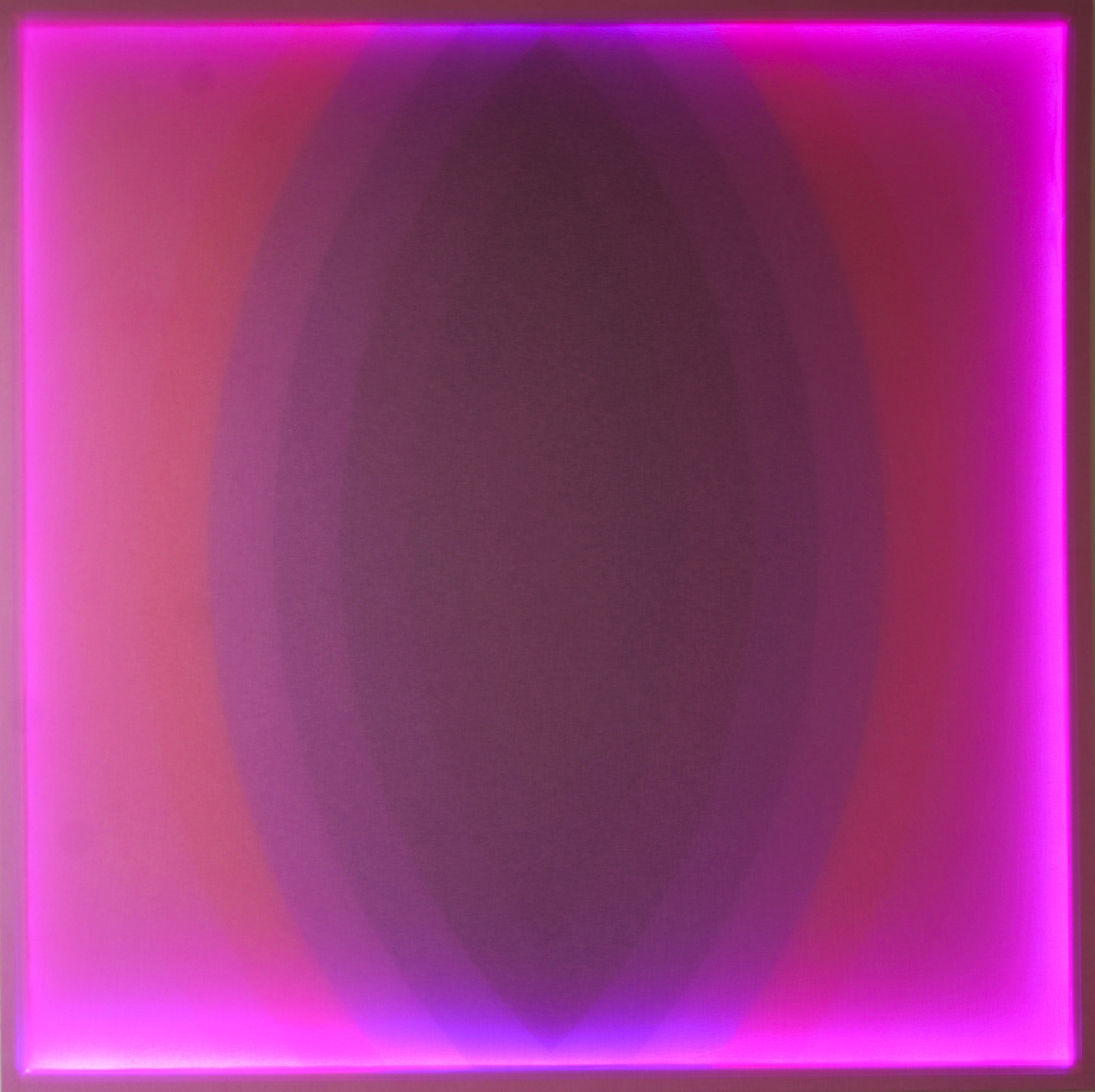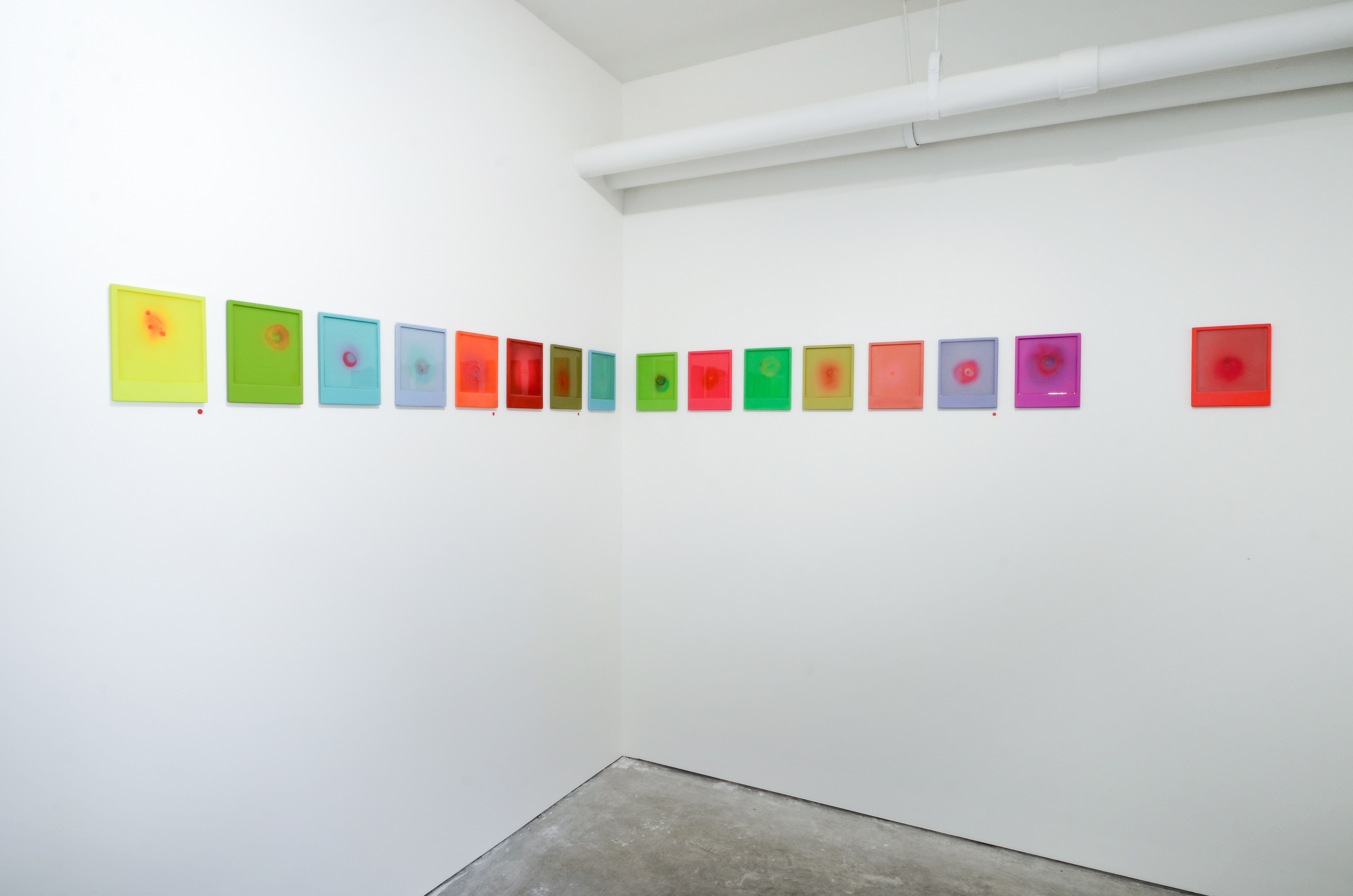

ABOVE: Install at Quappi Projects
(((heat)))
ReviewSince John Brooks opened Quappi Projects in 2017, the gallery has earned a reputation as one of the most intriguing places to encounter new art in Louisville. Quappi Projects is now located in an appropriately contemporary space between older facades on East Market Street. Through a small courtyard, one enters the gallery to find a quiet, sparse room. Patches of natural light illuminate the space, as well as the curious glow of Letitia Quesenberry’s signature lightboxes. (((heat))) is a solo show by the Louisville artist, whose Portland studio Brooks describes as “a one-person factory” manufacturing optical experiences that hold viewers endlessly captive.
Quesenberry’s oeuvre begins with patterns from which each work diverges in material, color, shape, or composition. In “On Difference(s) in Contemporary Art,” feminist art theorist Amelia Jones writes, “No longer viewed as a more or less stable system of oppositions by which primarily, the masculine is defined as superior to a fixed notion of femininity as other, difference is now being actively conceptualized as a process of endless differentiations that result in continuously shifting identities and identifications.” Unbeholden to binary understandings of gender and sexuality, artists are emboldened to explore the rich spaces between static expectations. (((heat))) is an exercise in difference.
In each of her works, Quesenberry uses similar techniques to produce distinct visual experiences. The lightboxes are so precisely constructed that they almost appear to be permanent fixtures in the room. White frames contain rings of color illuminated by LEDs and visible through a dreamy haze of sanded plexiglass. The lights seamlessly change hues, keeping the viewer transfixed on the central point which seems to recede far deeper into the wall. Quesenberry freely diverges from any established formula; her experimentations are on full display. hyperspace 35 (2019) is an equilateral triangle whereas BLSH 5 (2019) is a large square with a lavender frame. BLSH 3, 5, 6, 7, and 9 (2019) have similar structures as the lightboxes but contain no LEDs. These variations so effectively absorb and reflect the natural light of the space that the viewer may fail to realize they are not illuminated from within.
The largest work in the room, big heat (2019), spans from floor to ceiling. The shape in the middle of this lightbox is a pointed oval, oriented vertically and reverberating outward in changing hues of pink and violet. big heat is shrouded with gauze rather than the usual layers of sanded plexiglass. The fabric acts as a curtain between the viewer and this glowing portal. The central shape is all-consuming, simultaneously familiar and mystical. In recent years, we have seen vulvas appear on protest signs, cross-stitches, t-shirts, and in Janelle Monae’s iconic pants in the music video for “Pynk.” Quesenberry has distilled this image into an abstract, geometric form. The pointed oval, or vesical piscis, resembles the mandorla found in Christian and Buddhist art, which often encloses holy figures like a halo. Instead of a frame or embellishment, this mandorla is an object of fascination itself. At this monumental scale, big heat engulfs the viewer like a stained glass window or an abstract expressionist painting, providing a mystical and divine experience in the center of the exhibition.
Considering (((heat))) in its entirety, the viewer senses that Quesenberry arrived at each variation methodically. A form that appears repeatedly in her work is a circle which expands from (or recedes into) a central point. This vortex-like composition appears not only in the lightboxes but also in anon 1 and 2 (2019). These two works are formatted like polaroid photos: a square within a rectangular frame. Both works have circular compositions that echo the lightboxes, but in these instances, the emanating rings are built with raised features that function like shallow relief. The light reflects off the polished surfaces and flat, opaque colors. Rather than constructing infinite, ambiguous space, here Quesenberry has constructed two cornerstones for the exhibition, bridging her train of thought between the lightboxes and the smaller polaroid works.
The polaroid-shape appears again in as of yet (2012-2019). This grouping consists of twenty-four smaller polaroid-shaped works, identical in size and arranged in a broken grid—each row and column contains random empty spaces. Some of the compositions are similar: squares and circles radiating from a central point, overlapping circles resting over a triangle, and solid fields of color or texture. The works range from neon pinks and greens to pastels and shades of grey. Quesenberry achieves distinct effects through her mastery of materials—this arrangement alone includes polished plaster, graphite, mirror, acrylic, glitter, spray paint, film, resin, and wax.
In Western art, the grid indicates classical order and balance—think of the carefully proportioned designs of Renaissance cathedrals and churches, modeled after the crucifix, Greek cross, or Vitruvian man and executed by male architects like Bramante, Palladio, and Michelangelo. If a grid represents order in the form of patriarchal, heteronormative expectations, then Quesenberry disrupts and challenges order in her sporadic grid of fascinating optics. In arrangements like as of yet and how this came to be (2018-2019), the artist performs a series of deviations, though it is unclear which one—if any—is the original. Most of the polaroid works are enshrined in lacquer or resin, fluid materials that have solidified after the artist finalized each variation.
Quesenberry’s work pushes boundaries within the frameworks she chooses to adopt. Her devotion to experimentation and the freedom she thus creates are the defiant qualities in her work. Rarely is Quesenberry’s challenge to patriarchal assumptions literal. She resists expectations by creating infinite space for diversification. (((heat))) leaves the viewer with a feeling of possibility and limitlessness.
-
(((heat))) is on display at Quappi Projects through September 6, 2019.
Quappi Projects is located at 827 E Market Street, Louisville, KY 40202 and is open Thursdays 12-4p, Fridays 12-5p, Saturdays 11a-3p, and by appointment.
Notes:
- Quappi Projects
- Letitia Quesenberry
- Encyclopedia Britannica. “Mandorla.” Iconography. Accessed August 17, 2019.
- Jones, Amelia. “Negotiating Difference(s) in Contemporary Art.” In Theories of Contemporary Art, edited by Richard Hertz. Englewood Cliffs: Prentice Hall, 1993.
- Wittkower, Rudolph. Architectural Principles in the Age of Humanism. New York: W.W. Norton & Company, 1998.
Mary Clore
Development & Outreach Editor, Contributor
8.21.19

as of yet (2012-2019), panel, polished plaster + graphite/mirror/acrylic/glitter/spray paint/film/resin/wax.

Install.

big heat (2019), panel, masonite, paint, LED, gauze, dye.

how this came to be (2018-2019), panel, lacquer, resin.







